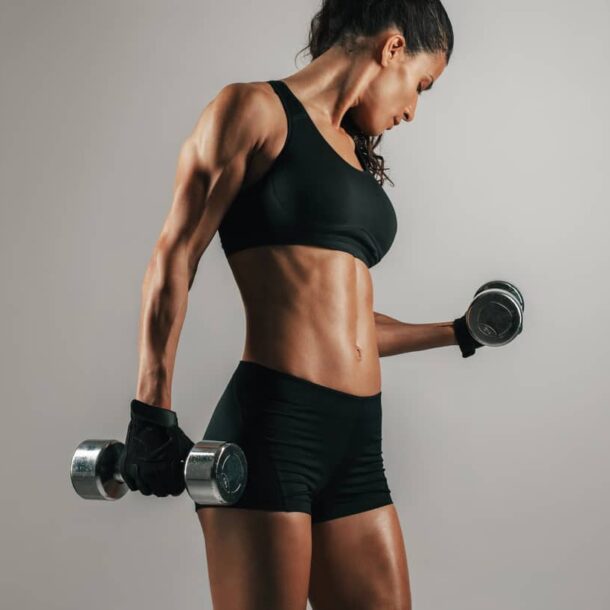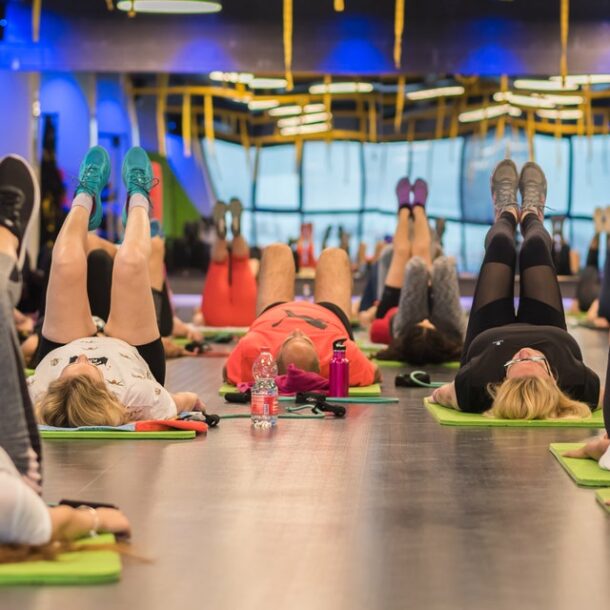
Side Fat Exercises For A Toned Midsection: HealthifyMe
Excess fat accumulation around the waist and sides, often referred to as “love handles” or “muffin tops,” can be a common concern for individuals seeking a sculpted and toned physique. These pockets of fat can affect self-confidence and overall appearance. While spot reduction is not a guaranteed solution, incorporating targeted exercises that focus on the oblique muscles can help strengthen the core, enhance posture, and contribute to a more defined waistline.
In this article, we delve into the world of side fat exercises, exploring the top-performing routines and techniques that have gained prominence on Google. We will discuss the importance of understanding the causes and concerns related to side fat while providing step-by-step instructions for effective exercises. Additionally, we’ll address the significance of a well-rounded fitness routine that includes cardio, proper nutrition, and overall healthy lifestyle choices.
Whether you’re aiming for a more sculpted midsection or looking to boost your core strength, this comprehensive guide will equip you with the knowledge to embark on a journey towards reducing side fat and achieving your fitness goals.
Understanding Side Fat: Causes and Concerns
Before delving into the realm of side fat exercises, it’s essential to grasp the underlying factors contributing to the accumulation of fat in the waist and side areas. While genetics play a role in determining how and where your body stores fat, there are several common causes and health concerns associated with excess side fat:
A. Dietary Habits
Poor eating habits, including a high intake of processed foods, sugary snacks, and excessive calorie consumption, can lead to weight gain and fat storage around the waistline.
B. Sedentary Lifestyle
Prolonged periods of sitting or inactivity can slow down metabolism and promote fat deposition in various areas, including the sides.
C. Hormonal Changes
Hormonal fluctuations, particularly imbalances in cortisol (the stress hormone) and insulin can contribute to fat accumulation around the midsection.
D. Lack of Cardiovascular Exercise
Insufficient cardiovascular activity can hinder fat burning and overall weight management, making it harder to reduce side fat.
E. Genetics
Genetic predisposition can influence fat distribution in the body, making some individuals more prone to storing fat around the waist and sides.
Summary
Before delving into side fat exercises, it’s vital to understand the factors behind excess fat around the waist and sides. These factors include poor dietary habits with processed foods and excessive calories, a sedentary lifestyle that slows metabolism, hormonal imbalances like high cortisol and insulin, insufficient cardiovascular exercise hindering fat burning, and genetic predispositions influencing fat distribution. Recognizing these factors is crucial for effective side fat reduction strategies.
Health Concerns Related to Excess Side Fat
Excess side fat, often accompanied by an expanding waistline, can have significant implications for overall health and well-being. Understanding the potential health concerns associated with this type of fat accumulation underscores the importance of addressing it through targeted exercises and a comprehensive wellness approach:
A. Increased Cardiovascular Risk
Fat stored around the waist and sides, known as visceral fat, is metabolically active and linked to a higher risk of cardiovascular diseases. This fat type can release inflammatory substances and impact blood vessel function, contributing to conditions such as heart disease, stroke, and atherosclerosis.
B. Insulin Resistance and Diabetes Risk
Excessive side fat is associated with insulin resistance, a condition where cells become less responsive to insulin’s effects, leading to elevated blood sugar levels. This can increase the risk of type 2 diabetes over time.
C. Hormonal Imbalances
Abdominal fat can influence hormonal balance, particularly cortisol and sex hormones. Hormonal imbalances can affect various bodily functions, including metabolism, reproductive health, and stress responses.
D. Breathing Difficulties
An expanding waistline can compress the diaphragm and limit lung expansion, leading to shallow breathing. This can affect lung capacity and overall respiratory function.
E. Postural Issues and Musculoskeletal Discomfort
Carrying excess side fat can alter posture by shifting the body’s centre of gravity. This may lead to muscle imbalances, back pain, and discomfort in the spine and hips.
F. Digestive Health Concerns
Visceral fat accumulation has been associated with an increased risk of gastrointestinal disorders and inflammation, potentially impacting digestion and overall gut health.
G. Sleep Apnea Risk
Abdominal fat can contribute to sleep apnea, a condition characterised by pauses in breathing during sleep. Sleep apnea disrupts restful sleep and is associated with various health complications.
H. Psychological and Emotional Impact
Body image concerns from excess side fat can affect mental health, leading to lower self-esteem, reduced self-confidence, and even depression or anxiety.
I. Chronic Inflammation
Visceral fat is known to release pro-inflammatory substances, contributing to chronic low-level inflammation in the body. This inflammation is linked to various chronic diseases.
Summary
Excess side fat, often accompanied by an expanding waistline, poses substantial health risks. It’s associated with heightened cardiovascular risk due to metabolically active visceral fat, potentially leading to heart disease, stroke, and atherosclerosis. Additionally, excessive side fat contributes to insulin resistance, hormonal imbalances, breathing difficulties, postural issues, and musculoskeletal discomfort. It can also impact digestive health, increase the risk of sleep apnea, and have psychological and emotional implications, including lower self-esteem and depression. Furthermore, visceral fat can promote chronic inflammation, further emphasizing the importance of addressing side fat through targeted exercises and a holistic wellness approach.
Side Fat Exercises
A. Plank Hip Dips
Execution: Begin in a forearm plank position with your elbows directly below your shoulders. Twist your hips to the right, lowering them towards the floor without touching it. Return to the centre and repeat on the left side.
Target Muscles: Plank hip dips primarily engage the obliques and also work the rectus abdominis and transverse abdominis.
Tips: Maintain a straight line from head to heels, engage your core, and perform the movement in a controlled manner. Avoid sagging hips.
B. Russian Twists
Execution: Sit on the floor with knees bent, and feet flat. Lean back slightly and lift your feet off the ground. Hold a weight or medicine ball with both hands and twist your torso to the right, then to the left, tapping the object on the ground beside your hip each time.
Target Muscles: Russian twists effectively engage the obliques, rectus abdominis, and hip flexors.
Tips: Keep your back straight, maintain a balanced position on your sit bones, and engage your core throughout the exercise.
C. Side Planks
Execution: Begin in a forearm plank position, then rotate your body to one side, stacking your feet on top of each other. Lift your hips off the ground, creating a straight line from head to heels.
Target Muscles: Side planks primarily target the oblique muscles, also engaging the transverse abdominis and glutes.
Tips: Focus on maintaining a straight line and avoid letting your hips sag. You can modify it by bending your bottom leg for added stability.
D. Bicycle Crunches
Execution: Lie on your back with hands behind your head. Lift your legs and bend your knees. Bring your right elbow and left knee toward each other while extending your right leg straight. Alternate sides in a pedalling motion.
Target Muscles: Bicycle crunches engage both the obliques and the rectus abdominis.
Tips: Keep your elbows wide, avoid pulling on your neck, and engage your core to lift your shoulder blades off the ground.
E. Woodchoppers
Execution: Stand with your feet shoulder-width apart, holding a dumbbell or medicine ball with both hands. Start with the weight over one shoulder, then twist your torso and bring it diagonally across your body to the opposite hip.
Target Muscles: Woodchoppers work the obliques, shoulders, and core.
Tips: Engage your core, pivot your feet as you rotate, and control the weight’s movement to avoid straining your back.
Incorporating these exercises into your fitness routine, along with proper form and consistency, can help you effectively target and reduce side fat while strengthening your core muscles. Remember to start at your own fitness level and gradually increase intensity and repetitions as you progress.
Other Lifestyle Factors for Side Fat Reduction
Achieving a leaner waistline and reducing side fat isn’t solely about exercise. Your overall lifestyle plays a crucial role in the effectiveness of your fitness efforts. Here are essential lifestyle factors to consider for side fat reduction.
A. Balanced Nutrition
Nutrient-Dense Diet: Consume a diet rich in whole foods, including fruits, vegetables, lean proteins, whole grains, and healthy fats. Minimize processed foods, sugary beverages, and excessive calorie intake.
Calorie Control: Monitor your calorie intake to ensure it aligns with your fitness goals. Create a calorie deficit for fat loss, but do so gradually and sustainably.
Portion Control: Pay attention to portion sizes to avoid overeating, even when consuming healthy foods.
B. Hydration
Staying well-hydrated is essential for overall health and can help control appetite. Aim for at least 8-10 glasses of water per day.
C. Cardiovascular Exercise
Complement your side fat exercises with regular cardiovascular activities like running, swimming, or cycling to enhance calorie burn and overall fat loss.
D. Stress Management
Stress Reduction Techniques: Chronic stress can lead to weight gain and fat retention, including around the waist. Practice stress management techniques such as meditation, yoga, deep breathing, or mindfulness to keep stress levels in check.
E. Adequate Sleep
Ensure you get 7-9 hours of quality sleep per night. Poor sleep can disrupt hormone balance, leading to increased appetite and weight gain.
F. Alcohol Moderation
Limit Alcohol: Excessive alcohol consumption can contribute to weight gain and fat accumulation. Limit your alcohol intake or opt for lower-calorie drink choices.
G. Smoking Cessation
If you smoke, consider quitting. Smoking can affect metabolism and overall health negatively.
H. Consistency and Patience
Long-Term Commitment: Understand that spot reduction is not realistic, and results take time. Stay consistent with your exercise and nutrition plan, and be patient with the process.
I. Regular Health Check-Ups
Medical Evaluation: Visit a healthcare provider for regular check-ups to monitor your overall health and discuss your fitness and weight management goals.
J. Social Support
Share your fitness journey with friends or join a fitness community for support, motivation, and accountability.
K. Customised Approach
Recognise that what works for one person may not work for another. Consider working with a nutritionist or personal trainer to create a customized plan tailored to your unique needs and goals.
L. Educate Yourself
Learn about nutrition and how different foods affect your body. Knowledge empowers you to make informed dietary choices.
Summary
Achieving a leaner waistline and reducing side fat is not solely dependent on exercise but also on various lifestyle factors. These include maintaining a balanced and nutrient-dense diet, controlling calorie intake, practicing portion control, staying adequately hydrated, incorporating cardiovascular exercise, managing stress through techniques like meditation and yoga, ensuring sufficient sleep, moderating alcohol consumption, considering smoking cessation, committing to long-term consistency and patience, scheduling regular health check-ups, seeking social support for motivation, embracing a customized approach tailored to individual needs, and acquiring knowledge about nutrition to make informed dietary choices. All of these factors play a crucial role in achieving effective side fat reduction.
HealthifyMe Suggestion
Fat cells form when your body consumes too many calories or when you do not burn as many calories as you consume. These fat cells might become visible over time as they become noticeable in certain areas, such as around your waist and hips. Make gradual changes to your food, workout programme, and lifestyle to lose fat and keep it off. Leafy greens and whole grains are low in fat and calories while providing fibre along with vital nutrients and vitamins. Lean proteins, such as fish and white meat, as well as beans and lentils, should be consumed more frequently.
Conclusion
In conclusion, the journey to reducing side fat and achieving a trimmer waistline involves a multifaceted approach that encompasses not only targeted exercises but also a holistic adjustment of your lifestyle. Recognizing the underlying factors contributing to side fat accumulation, including dietary habits, sedentary living, hormonal imbalances, and genetics, lays the foundation for effective fat reduction strategies. Understanding the potential health risks linked to excess side fat, such as cardiovascular diseases, diabetes, and postural issues, underscores the importance of taking action through exercise and healthy living.
Incorporating top-performing side fat exercises, as discussed earlier, is a significant step in the right direction. Still, it’s equally vital to address other lifestyle aspects. Balancing nutrition, staying hydrated, engaging in cardiovascular activities, managing stress, prioritizing sleep, and moderating alcohol consumption are key elements of this comprehensive strategy. Moreover, consistency, patience, and a willingness to adapt to individual needs and preferences are crucial in achieving sustainable results.
By embracing this holistic approach, you not only enhance your chances of reducing side fat effectively but also improve your overall health and well-being. It’s a journey that requires dedication, but the rewards in terms of improved fitness, confidence, and long-term health are well worth the effort. Remember that every step you take towards a healthier lifestyle brings you closer to your goal of a slimmer waistline and a happier, healthier you.
Disclaimer: The purpose of this article is just to disperse knowledge and raise awareness. It does not intend to replace medical advice from professionals. For further information please contact our certified nutritionists Here
Frequently Asked Questions (FAQs)
Can I reduce side fat with specific exercises?
While exercises targeting the oblique muscles can strengthen and tone the area, spot reduction is generally ineffective. To reduce side fat, it’s crucial to combine targeted exercises with overall fat loss through a balanced diet and cardiovascular exercise.
How often should I do side fat exercises?
Aim for at least 3-4 times a week, incorporating a variety of side fat exercises into your routine. Allow your muscles to rest and recover between workout sessions.
How long does it take to see results in fat reduction?
The timeline for seeing results varies from person to person and depends on factors like diet, exercise consistency, and genetics. Generally, visible results may take several weeks to a few months.
Are there any dietary changes I should make to reduce side fat?
Focus on a balanced diet rich in whole foods, lean proteins, fruits, vegetables, and healthy fats. Monitor your calorie intake to create a calorie deficit for fat loss and avoid excessive sugar and processed foods.
Can I reduce side fat without exercise by diet alone?
Diet plays a significant role in weight management, but exercise, especially strength training and cardiovascular workouts enhances fat loss and helps shape the body.
Are there any side effects to be aware of when doing side fat exercises?
When done with proper form, side fat exercises are generally safe. However, using improper form or excessive weight can lead to strains or injuries. Consult a fitness professional if you’re unsure about your technique.
Can I do side fat exercises if I have a history of back problems?
If you have a history of back problems, it’s essential to consult with a healthcare professional or physical therapist before attempting side fat exercises. They can provide guidance on exercises that are safe and appropriate for your condition.
Is there a specific time of day when side fat exercises are most effective?
The best time to do side fat exercises is when you can maintain consistency. Some prefer morning workouts for their metabolism-boosting benefits, while others prefer evenings for stress relief. Choose a time that fits your schedule and allows you to be consistent.
Can side fat exercises help improve posture?
Yes, strengthening the core muscles through side fat exercises can improve posture by promoting a strong and stable midsection. Better posture can alleviate back pain and enhance overall body alignment.
What should I do if I’m not seeing results from my side fat exercises?
If you’re not seeing the desired results, consider adjusting your exercise routine, diet, or overall lifestyle. It’s essential to give your body time to adapt, but if progress stalls, consult a fitness professional or nutritionist for personalized guidance.
Reference Sources
- Role of Body Fat Distribution and the Metabolic Complications of Obesity: https://www.ncbi.nlm.nih.gov/pmc/articles/PMC2585758/
- Endocrine Changes in Obesity: https://www.ncbi.nlm.nih.gov/books/NBK279053/
- Role of Overweight and Obesity in Gastrointestinal Disease: https://www.ncbi.nlm.nih.gov/pmc/articles/PMC7019431/
- The Psychosocial Burden of Obesity: https://www.ncbi.nlm.nih.gov/pmc/articles/PMC6052856/
2023 Bodyfender @ All Rights Reserved


